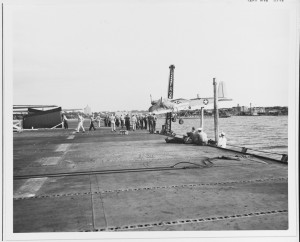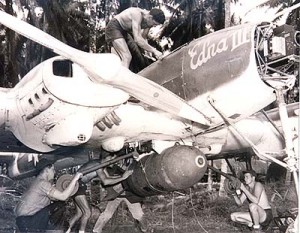
There were many technological advances in WWII involving the US Navy. The US Navy used a large amount of aircraft carriers for staging airplanes in the Pacific Theater. This technology was implemented in the 1920s, including the USS Langley as the Navy’s first aircraft carrier [10]. The first techniques of launching airplanes from carriers included slingshots and wire guiding. However, by the end of the 1920s, airplanes began to take off and land on aircraft carriers without much assistance. By 1940 and the entrance to WWII, the US Navy had a fleet of aircraft carriers active in the Pacific Ocean. As the aircraft carrier became more apparent, so did the different types of aircraft associated with it.
Unmanned Airplanes
During WWII, there was a new technology that wasn’t been released to the public. WWII was the first war of applicable drone warfare. Unmanned flight dates back to WWI but there was not enough development in remote control systems at this point to produce efficient drones. In the 1930s, the Royal Navy created remote controlled aircraft to be used as targets for anti- aircraft weapons. One of these included the “Queen Bee” and helped to determine flaws in anti-air weapons. Impressed by this drone, the US Navy decided to created their own unmanned aircraft. Lt. Commander Delmar Fahrney was selected to lead this project. He added radio controls to a bi plane but realized the challenges of not being able to see. Fahrney teamed up with a TV inventor from RCA to create television guidance within an airplane. Together, they created the first television guided airplane and previewed it in 1940 although it did not raise much interest [5].
Drones, or Unmanned Ariel Vehicles (UAVs), have been used in the United States military ever since the end of WWII. The first kind of UAVs were guided missiles. The UAVS could be launched from a B-22 and then guided to their target. The Germans also created a similar technology using radio waves to guide missiles dropped from zeppelins. Although the U.S. created a drone that could be used for reconnaissance, it was not effective since the weather conditions had to be ideal.
While drones were being dropped from the air, some were also being released from the ground and even aircraft carriers. There had to be a piloted plane in the air to control the drone. These drones acted more like a plane and less like a bomb. The Naval dedicated a special unit called Special Task Air Group One (STAG-1) to oversee the combat drone development. Stag-1 officially became part of the US Navy’s Special Air Task Force (SATFOR) in 1943. The first ever combat drone created was called the Torpedo Drone (TDR-1) [11]. They were called torpedo drones because they were used as guided torpedoes in the air with a very high accuracy. This drone was one of the most technologically advanced pieces of equipment of it’s time. It was equipped with a first-generation TV monitor system that allowed a picture from up to 30 miles away with radio remote controls along with the ability to deliver a 2000 lb. payload. These drones were used to safely deliver munitions against the enemy without risking the lives of Naval Aviators. They could even be used as Kamikaze planes without the sacrifice of life.
Drones Come to Traverse City
STAG-1 began testing on these drones and how they would be used in the war. Testing began in Clinton, Oklahoma where they launched TDR-1s from runways of over 2 miles long [1]. These missions were designed to get acclimated to launching, landing, and controlling the drone in the air. After significant training was completed in Oklahoma, Stag-1 personal and the TDR-1s were shipped up to Traverse City, Michigan for additional training.
The training that Stag-1 completed was top-secret. Most of the training in Traverse City occurred in Grand Traverse West Bay. The mission was to take the proven technology from Oklahoma along with the Naval Aviators to open water. The pilots and equipment were all moved during the middle of the night by train to not raise suspicion [4]. This mission was to remain a secret; thus no one could know about it due to possible espionage.
The drones had to practice landing and taking off an aircraft carrier stationed in West Bay. The aircraft carrier, U.S.S. Sable, was a converted great lake paddle steamer and was one of two aircraft carriers used for Naval pilot training in Lake Michigan [10]. Many of the launches included a slingshot to get the drones into the air. However, the first “free” take-off and landing occurred on the USS Sable [7]. They would also take off from the U.S. Naval Air Station, now Cherry Capitol Airport, and conduct missions in the northernmost part of Michigan’s lower peninsula. These missions included bombing a target or just crashing the drone directly into it. The citizens of Traverse City saw many planes flying above, but no one knew that there was no pilot in one of the planes [8]. The front plane was the drone and the other plane flying included the pilot along with the operator of the drone. Also, many of the missions executed occurred in the middle of the night to avoid making a skeptical.

In 1944 over 1000 enlisted Navy and 150 Naval officers occupied Traverse City. Many of these Naval personnel were somehow involved in the STAG-1 project. The native population would raise suspicion, but it would often subside. In once incidence, a TDR-1 crashed into the bay with many civilians watching [8]. They were appalled that there was no attempt to rescue the occupants of it. No one suspected that the plane had no occupants.
Nord Tengstrom recalled that “We trained in Traverse City, Michigan where we made long distance, over water, practice runs on a lighthouse with a 50-mile separation between drone and control plane. We lived in the Grand Traverse Hotel until quarters were ready on the base” [2]. Many of the STAG-1 personal had nothing but good things to say about the Traverse City area. Robert Bothfeld recalls “that all of the people were so friendly and that quite a few of them married some good women from the area.” He also points out that some of the food “was caught last night in the bay” and that he “Loved it there!” [2]. Although Stag-1 enjoyed their time in Traverse City, they were only stationed from August – November 1943. From Traverse City, Stag-1 was sent to Monterey, California before the winter set in.
Pacific Theater
STAG-1 was stationed in California until they got deployed to the Pacific Theater, implementing the new drone operation against the Japanese. Naval staff had originally wanted an order of 18 squadrons including 1000 drones. This order quickly got cut due to the need for more supplies in the Pacific Theater. The Navy’s carrier force was successfully supporting General MacArthur’s island hopping campaign using conventional weapons. There was not a direct need to deploy assault drones to the Pacific. The unit ended up with 114 drones and only 50 of them were deployed. The rest were used for training or on reserve. The Stag-1 unit had to be evaluated in combat though before final decisions were made about the success of the TDRs.
http://www.youtube.com/watch?v=8RQcUtzAe98
In May of 1944, 2 squadrons of SATFOR drones arrived in Banika, just north of Guadalcanal. Four TDR-1s armed with a 1 ton bomb departed from Banika to destroy a Japanese Freighter, Yamazuki Maru, in Cape Esperance, Guadalcanal. The first drone strikes the target at the correct time. The second overshoots by 5 feet. The third drone fails to explode while the forth strikes the target, completing the operation [3]. This operation can be seen via live footage above.
A 30-day combat mission in September was proven to be successful on Bougainville Island as well. STAG-1 destroyed a Japanese anti-aircraft battery, artillery, bridges, tunnels, supply dumps, and a lighthouse. These efforts were especially helpful to the troops on the ground. Bougainville Island was a strategic island that could be used as a main airbase during operations in the Philippines. The United States took control of it in late 1944.
Another assault occurred on Rabaul, a Japanese base taken from Australia. They attacked through heavy anti-aircraft fire, proving the use for unmanned drones. This attack was primarily completed to test the drones, because no military allies were at Rabaul during 1944. A strategy of having a pilotless bomber was tried as well. In October, a single TDR-1 was armed with 10 smaller bombs and dropped them on gun emplacements on Ballale Island. This was one of the many bombing raids that occurred on the Island. Following this attack, TDR-1s dropped their bombs on island targets and then flew into Japanese cargo ships [11].
Mission Complete

STAG-1 sent forty-six drones into combat and 21 were proven to be successful hits. The most amazing feat is that not one Stag-1 aviator was lost or killed during any mission. Admiral King (Commander in Chief, United States Fleet) choose to adopt one of the assault drones from the army instead of continuing with the TDR. That December of 1944, the Navy discontinued the SATFOR group and the development of TDRs. The remaining drones were used as target practice or destroyed. The last surviving TDR is the Edna III and can be seen at the National Naval Aviation Museum [6].
SATFOR was discontinued for many reasons. One of the reasons being that the drone project was labeled by the Navy as experimental. This denied them access to the industrial resources that many other technologies could utilize. Also, the Pacific Theater was wrapping up by the time the TDRs were ready to be used. Commanders thought of the drones as unnecessary and impractical, especially because there was no direct need for them. The drones did prove themselves, but at the cost of economic resources and time.
The missions completed by SATFOR group were the first successful use of guided missiles and drone warfare in U.S. history. This drone project paved the way for future technology, even though the topic was heavily disregarded for 7 years. The STAG-1 has made it possible to create the technology that there is today.
Primary Sources:
- Tengstrom, Norman. “Epilogue” Special Task Air Group One. 1997. N.p.
- Matheny, Keith. “TC Had Key Role in Secret WWII Project.” Record-Eagle. 1999. N.p.
- “Service Test in Field of TDR1 – WWII, Torpedo.” YouTube, Uploaded by PeriscopeFilm, 13 Dec 2012.
- Beadleston, Nick, “Yes An Aircraft Carrier On Grand Traverse Bay.” The Ticker. 18 Feb, 2015
Secondary Sources:
- Lee, Bill. “First Operational US Navy Drone.” September 2013. Pp. 1-11.
- National Naval Aviation Museum. “TRD-1 EDNA III.” 2016. N.p.
- Vintage Wings of Canada. “The Great Lakes Paddle Wheeler Aircraft Carriers.” Vintage News. 2013. N.p.
- O’Brien, Bill. “Marker Tribute to Secret WWII Work.” Record-Eagle. 2011. N.p.
- Ellison, Garret. “Lake Michigan Navy Carriers.” M-Live. 2015. N.p.
- United States Naval Aviation. “Dictionary of American Naval Fighting Ships.” 1910-1970. N.p.
- Newcome, Laurence R. Unmanned Aviation: A Brief History of Unmanned Aerial Vehicles. American Institute of Aeronautics and Astronauts, 2004.
Further Reading:
- Newcome, Laurence R. Unmanned Aviation: A Brief History of Unmanned Aerial Vehicles. American Institute of Aeronautics and Astronauts, 2004.
